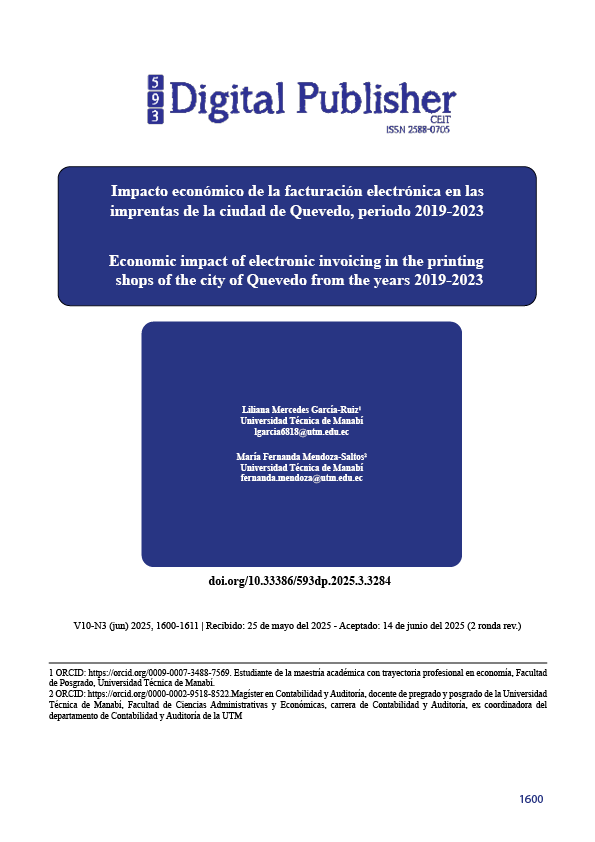Economic impact of electronic invoicing in the printing shops of the city of Quevedo from the years 2019-2023
Main Article Content
Abstract
In Ecuador, the printing industry has been a key ally in the physical issuance of tax receipts authorized by the Servicio de Rentas Internas (SRI). However, in recent years, due to the mandatory electronic invoicing, many printers have seen their income affected, facing challenges to maintain their service. To study the economic impact and resilience of printing shops to these new tax requirements, a non-probabilistic sampling was carried out and a survey was applied to 16 of these businesses authorized by the SRI in Quevedo. A significant reduction in the issuance of tax receipts and in the number of employees was observed in the printing companies after the mandatory electronic invoicing. The economic situation of the same before and after the mandatory implementation of electronic invoicing indicates that there is no association with the time that the printers have remained in the market, so this measure can affect all printers. Similarly, no association was found between the business opportunities generated with electronic invoicing or with the diversification of services of the printing companies. Ninety-four percent of printers have been affected by mandatory electronic invoicing, and 31% have not offered new services. The sector's perception is that access to credit and the adoption of new technologies could be key alternatives to strengthen its resilience in the face of these new challenges.
Downloads
Article Details

This work is licensed under a Creative Commons Attribution-NonCommercial-ShareAlike 4.0 International License.
1. Derechos de autor
Las obras que se publican en 593 Digital Publisher CEIT están sujetas a los siguientes términos:
1.1. 593 Digital Publisher CEIT, conserva los derechos patrimoniales (copyright) de las obras publicadas, favorece y permite la reutilización de las mismas bajo la licencia Licencia Creative Commons 4.0 de Reconocimiento-NoComercial-CompartirIgual 4.0, por lo cual se pueden copiar, usar, difundir, transmitir y exponer públicamente, siempre que:
1.1.a. Se cite la autoría y fuente original de su publicación (revista, editorial, URL).
1.1.b. No se usen para fines comerciales u onerosos.
1.1.c. Se mencione la existencia y especificaciones de esta licencia de uso.
References
Abundis E.V.M. (2016). Beneficios de las encuestas electrónicas como apoyo para la investigación. TLATEMOANI Revista Académica de Investigación, 7(22), 168-186. https://dialnet.unirioja.es/servlet/articulo?codigo=7286080
Arellano-Romero, N.N., Moncayo-Nieto, N.S., y Eras-Agila, R.J. (2023). Impacto de la facturación electrónica en imprentas de la Provincia de El Oro, cantones Pasaje-Machala. Polo del conocimiento, 8(3), 2945-2964. https://polodelconocimiento.com/ojs/index.php/es/article/view/5469
Arias-Gómez, J., Villasís-Keever, M.Á., y Miranda N.M.G. (2016). El protocolo de investigación III: la población de estudio. Revista Alergia México, 63(2), 201-206. https://www.redalyc.org/articulo.oa?id=486755023011
Baque Suárez, X.Y., y Bajaña Mendieta, I.L. (2021). Estudio de la evolución del diseño publicitario en imprentas del Cantón Quevedo. Ingeniería e Innovación, 9(2): 44-46. https://doi.org/10.21897/rii.2426
Barreix, A., y Zambrano, R. (2018). La Factura Electrónica en América Latina: proceso y desafíos. En Barreix, A. y Zambrano, R. Factura Electrónica en América Latina. Banco Interamericano de Desarrollo (BID) / Centro Interamericano de Administraciones Tributarias (CIAT). chrome-extension://efaidnbmnnnibpcajpcglclefindmkaj/https://www.ciat.org/Biblioteca/Estudios/2018_FE/2018_Factura-Electronica_AL_BID_CIAT.pdf
Becerra, M.E., y Ojeda, O.R. (2022). Beneficios de la facturación electrónica en las pequeñas y medianas empresas del Ecuador. Visionario Digital, 6(4), 76-97. https://doi.org/10.33262/visionariodigital.v6i4.2366
Cabezas-Guilcapi, V.R., y Andrade-Rodríguez, J.M. (2022). Fortalecimiento en la recaudación tributaria mediante la implementación de facturación electrónica. Polo del conocimiento, 6(3), 1617-1625. https://polodelconocimiento.com/ojs/index.php/es/article/view/2457/5096
Cadena, M.P. (2006). La factura electrónica en el Ecuador. Foro, Revista de Derecho, 5, 241-267. https://www.redalyc.org/articulo.oa?id=90071542010
Chavarría, H.E.J., Zamora, M.L.J. y Junco, A.W.W. (2017). Ventajas y desventajas de la implementación de la Facturación electrónica en el Ecuador. Revista Científica de Investigación actualización del mundo de las Ciencias, 1(4), 473-499. https://doi.org/10.26820/reciamuc/1.4.2017.473-499
Da Silva, S.R., Hernández Aros, L., Da Silva, M.W., y Gallego Cossío, L.C. (2016). Análisis del modelo operativo de la factura electrónica colombiana. Revista Científica Hermes, 15, 142-172. http://www.redalyc.org/articulo.oa?id=477656007008
Díaz-Córdova, J., Coba-Molina, E., y Bombón-Mayorga, A. (2016). Facturación electrónica versus facturación clásica. Un estudio en el comportamiento financiero mediante estudios de casos. Revista Ciencia UNEMI, 9(18), 63-72. https://doi.org/10.29076/issn.2528-7737vol9iss18.2016pp63-72p
Dini, M., Corona, J., y Sánchez, J. (2002). Adquisición de tecnología, aprendizaje y ambiente institucional en las PYME: el sector de las artes gráficas en México. CEPAL. https://www.cepal.org/es/publicaciones/4511-adquisicion-tecnologia-aprendizaje-ambiente-institucional-pyme-sector-artes
Gómez-Duque, E. (2021). Ventajas de la facturación electrónica durante la pandemia del Covid-19. Revista Reflexiones y Saberes, 15, 55 – 61. https://revistavirtual.ucn.edu.co/index.php/RevistaRyS/article/view/1331
Leguizamón Gaette, J.D., y Lugo Bareiro, S. (2024). Implementación de la facturación electrónica en América Latina. Revisión de literatura. Arandu UTIC, 11(2), 2564-2587. https://doi.org/10.69639/arandu.v11i2.446
Moreano Guerra, C.B., Lalangui Aguilar, B.M., Escobar Erazo, T.E., y Mena Freire, V.G. (2023). La facturación electrónica ventajas y desventajas en las pequeñas empresas del Ecuador. Ciencia Latina Revista Científica Multidisciplinar, 7(4), 3315-3340. https://doi.org/10.37811/cl_rcm.v7i4.7176
Ortega Méndez, J. X. (2023). Ventajas tributarias de la facturación electrónica en Ecuador. Revista de ciencias sociales y económicas, 7(1), 44–56. https://doi.org/10.18779/csye.v7i1.659
Quesada, V., Rodríguez, R., y Salazar, E. (2012). Estudio de factibilidad para la creación de una empresa dedicada a ofrecer: soluciones integrales de impresión para empresas y emprendedores de Guayaquil. Escuela Superior Politécnica del Litoral. chrome-extension://efaidnbmnnnibpcajpcglclefindmkaj/https://www.dspace.espol.edu.ec/bitstream/123456789/24313/1/Articulo%20Quezada%20Rodriguez.pdf
R Development Core Team. (2024). R: A language and environment for statistical computing. https://www.R-project.org/
Ramírez, L.C.A. (2022). El covid 19 y la afectación contable en tiempos de pandemia. Actualidad Contable Faces, 25,(44), 64-78. https://www.redalyc.org/articulo.oa?id=25772099005
Ramírez Á.J., Oliva, N., y Andino, M. (2018). Perfil de la Factura Electrónica. En Barreix, A. y Zambrano, R. Factura Electrónica en América Latina. Banco Interamericano de Desarrollo (BID) / Centro Interamericano de Administraciones Tributarias (CIAT). chrome-extension://efaidnbmnnnibpcajpcglclefindmkaj/https://www.ciat.org/Biblioteca/Estudios/2018_FE/2018_Factura-Electronica_AL_BID_CIAT.pdf
Redondo, A. (1999). Factores de competitividad en el sector de artes gráficas en España. Revista de dirección, organización y administración de empresas, 21, 116-125. https://doi.org/10.37610/dyo.v0i21.298
Saavedra, M.L. y Hernández, Y. (2008). Caracterización e importancia de las MIPYMES en Latinoamérica. Actualidad Contable FACES, 11(17), 122-134. https://www.redalyc.org/articulo.oa?id=25711784011
Tosca, M.S., Mapén, F.F.J., y Martínez, P.G. (2021). Facturación electrónica como herramienta para aumentar la productividad de la empresa. Revista Digital Investigación & Negocios, 14(23), 6-15. https://doi.org/10.38147/invneg.v14i23.124
Velazco Borda, J.L. de. (2016). La facturación electrónica en el Perú. Revista Lidera, 11, 4-10. https://revistas.pucp.edu.pe/index.php/revistalidera/article/view/16873
Zamora Choez, E.L., y Monar Merchán, C.A. (2024). Facturación Electrónica y su Impacto Económico en las Imprentas Autorizadas por el Servicio de Rentas Internas (SRI) de Manta. Revista científica de salud y desarrollo humano, 5(1): 151-171. https://doi.org/10.61368/r.s.d.h.v5i1.83



